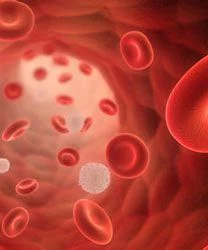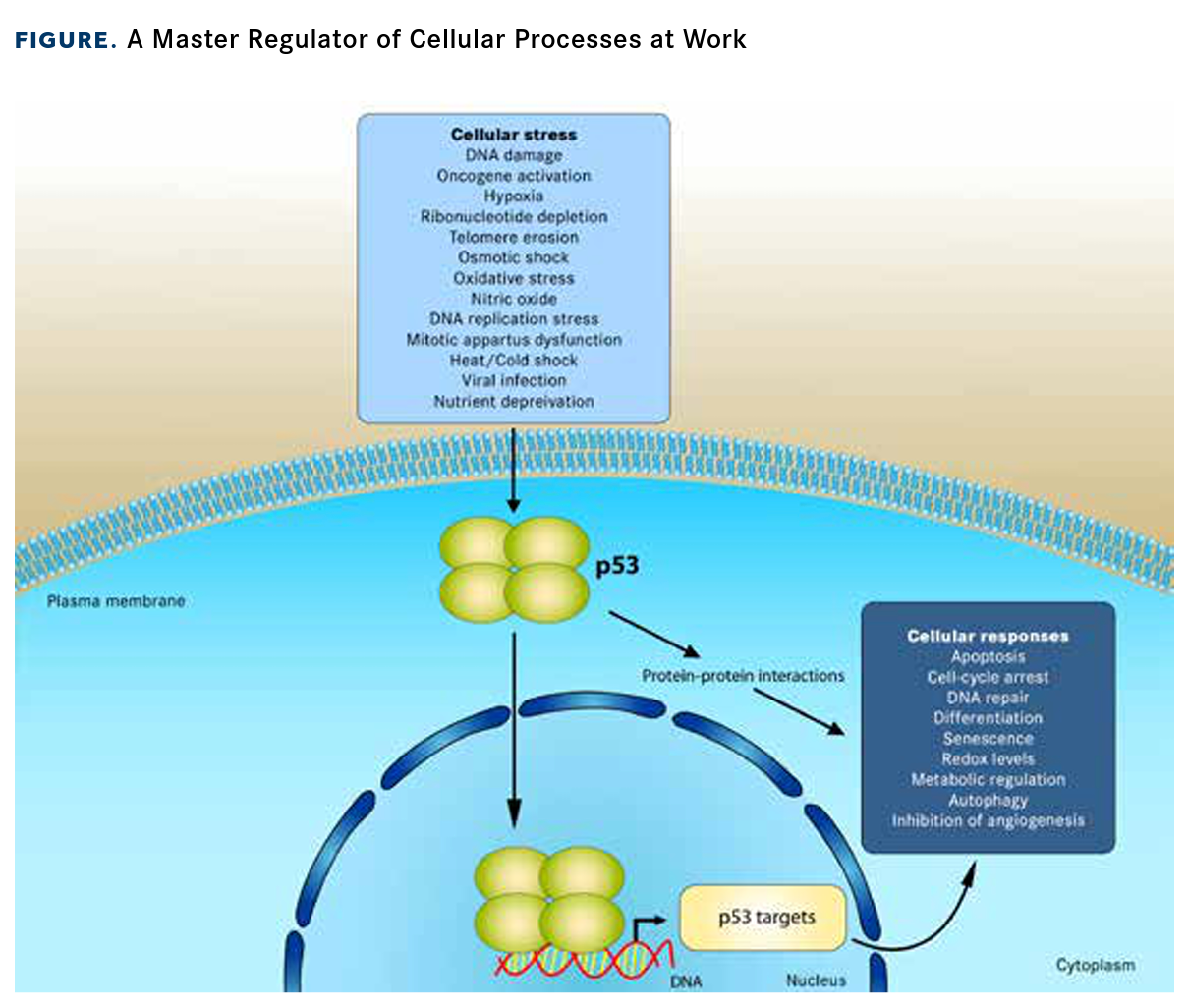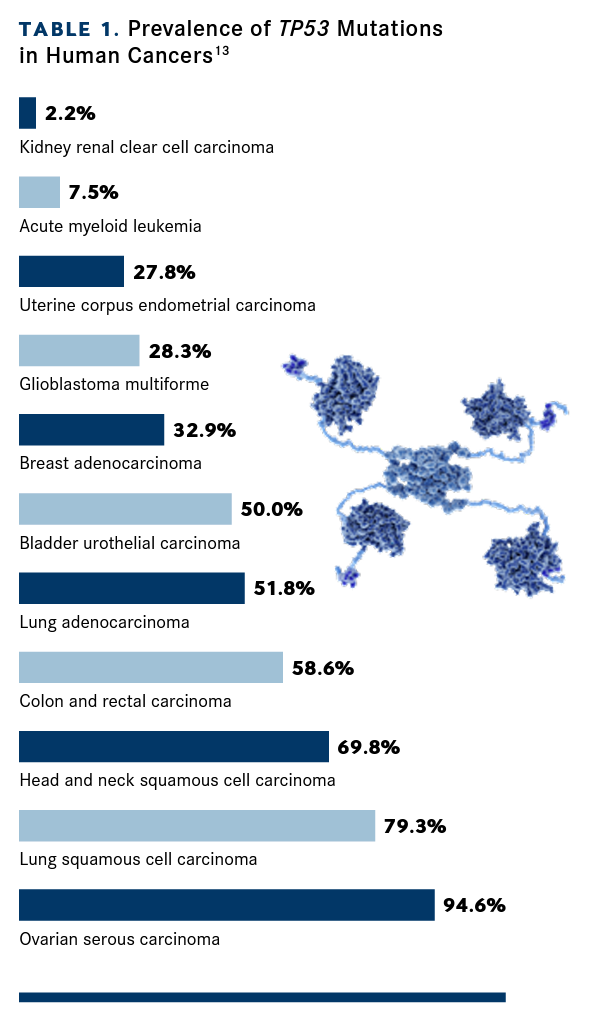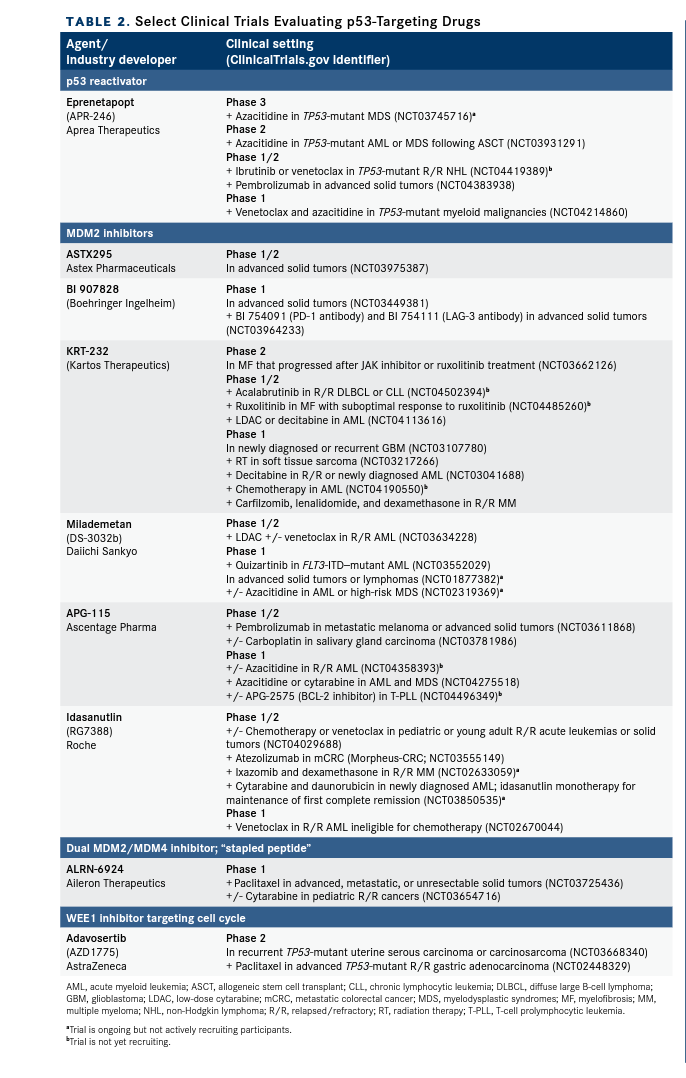Publication
Article
Oncology Live®
Novel Strategies for Targeting the “Guardian of the Genome” Emerge
Author(s):
p53 presents a significant challenge for investigators, and the field is littered with clinical trial failures and abandoned drug development programs.

As the “guardian of the genome” and the most frequently mutated gene in human cancer, TP53 and the p53 tumor suppressor protein it encodes make a compelling therapeutic target with the potential for broad-based activity. But p53 presents a significant challenge for investigators, and the field is littered with clinical trial failures and abandoned drug development programs.1,2
This year was shaping up to be a landmark one for this intensively researched cancer drug target, with a hotly anticipated readout from a phase 3 trial of idasanutlin, a small molecule inhibitor of the p53-regulatory protein MDM2.3,4
However, results from the phase 3 MIRROS trial in patients with relapsed/refractory acute myeloid leukemia (AML) proved yet another disappointment5 for a field that has taken more than its fair share of blows over the decades.1,2
Nevertheless, investigators continue to push the boundaries of drug development in their efforts to develop novel p53-targeting agents and potential combinatorial strategies. Several companies are pursuing drugs that reactivate mutant forms of the p53 protein, restoring its tumor-suppressive properties.
One such agent, eprenetapopt (APR-246), received a breakthrough therapy designation in January 2020 for the treatment of patients with TP53-mutant myelodysplastic syndromes (MDS).6 Promising phase 2 data for the drug were highlighted at the 2019 American Society of Hematology Annual Meeting (ASH).7
Guardian of the Genome
Discovered more than 4 decades ago,8 the p53 protein is best known for its role as a transcription factor. Modulating the expression of multiple important genes positions p53 as a master regulator of a range of cellular processes, the most thoroughly studied being the DNA damage response.
Levels of p53 protein are generally low; however, in response to cellular stressors such as DNA damage, p53 is activated, accumulates in the nucleus, and induces the expression of genes that contain specific response elements. Among its targets are regulators of the cell cycle, DNA repair, and apoptosis, which allow the cell to pause cycling to repair damaged DNA or induce cell death if the damage is irreparable. In this way, p53 serves as a barrier to the genomic instability that fosters cancer development, earning it the nickname “guardian of the genome” (FIGURE).2,9-12
The p53 protein is composed of multiple functional domains: Two transactivation domains operate together and independently to mediate the transcription of p53 target genes, a proline-rich domain is implicated in p53-mediated inhibition of cell growth and stimulation of apoptosis, and a DNA-binding domain allows p53 to bind the promoters of target genes.2
In addition, p53 contains an oligomerization domain that enables it to form a homotetramer (required for transcription factor activity), a nuclear export signal, and an unstructured C-terminal domain that is targeted by post-translational modifications that fine-tune p53’s activity.2
The activity of p53 is tightly controlled by other mechanisms, most notably by 2 negative regulators, MDM2 and MDM4. MDM2 is an E3 ubiquitin ligase that tags p53 with the small molecule ubiquitin, promoting the removal of p53 from the nucleus and targeting it for degradation by the proteasome.1,2,9,11
Notably, the MDM2 gene is a transcriptional target of p53; thus, a negative feedback loop exists whereby p53 promotes the expression of its own negative regulator. MDM4 does not possess E3 ligase activity but interacts with MDM2 to promote ubiquitination of p53.2
FIGURE: The p53 protein, a transcription factor that regulates many cellular processes in response to stress, plays an important role as a tumor suppressor. Strategies for targeting dysregulated p53, which is implicated in approximately half of human cancers, include targeting its interactions with MDM2 proteins and the first-in-class p53 reactivator eprenetapopt.

Breached Defenses
The importance of p53 as a tumor suppressor is reflected in reports that it is mutated in approximately half of all human cancers.2,9,10,12 Its prevalence varies widely across tumor types, reaching up to 95% in high-grade serous ovarian cancer (TABLE 1).13
Somatic TP53 mutations are also extremely common in small cell lung cancer, pancreatic cancer, squamous cell carcinoma of the head and neck, and invasive breast cancer, particularly the triple-negative subtype.14
Meanwhile, germline mutations in TP53 are associated with the rare Li-Fraumeni syndrome, in which individuals have an increased risk of developing cancer over the course of their lifetime.11,12
Although many types of mutation have been identified in TP53, the vast majority occur within the DNA-binding domain, affecting p53’s ability to activate its target genes and leading to a loss of tumor- suppressive function.2,12
Interestingly, unlike other tumor suppressor proteins, which are usually affected by deletion or nonsense mutations, most TP53 mutations result in a single amino acid substitution.5 These missense mutations are broadly classified into 1 of 2 types: either contact mutations that directly impede p53’s ability to bind target genes’ DNA or structural mutations that induce a conformational change in the p53 protein that affects its function.2,10,12
Moreover, it is thought that the effect of mutant p53 on carcinogenesis may occur through more than just a passive loss of its tumor-suppressive capabilities. Mutant p53 can also affect wild-type p53 when both forms are present in the same cell. Unlike deletions or nonsense mutations, missense mutations allow the production of full-length (albeit defective) protein. This mutant p53 protein is capable of forming complexes with the wild-type protein that dampen the antitumor functions of the wild-type protein.10,14,15
The mutant form also has been shown to acquire protumorigenic functions through interaction with other proteins that play a role in various cancer hallmarks.2,10,12
Even in the absence of gene mutations, p53 function is often impaired in cancer cells. A major mechanism is through dysregulation of the MDM2 and MDM4 proteins, which are frequently overexpressed in various tumor types. Ultimately, the p53 pathway is thought to be nearly universally dysfunctional in human malignancies, making it an enticing therapeutic target.2,11
For decades, investigators have sought to harness the p53 protein in drug development, but tumor suppressor proteins are notoriously difficult to target and require unconventional therapeutic strategies. A variety of methods are under investigation today, according to a search of ClinicalTrials.gov. These include vaccines and agents with targets that affect p53 functions. One of the most prevalent strategies involves targeting MDM2 protein activity and one of the most innovative seeks to reactivate p53 regulation (TABLE 2).
TABLE 2: Prevalence of TP53 Mutations in Human Cancers13

Many Candidates for Inhibiting MDM2
Among the earliest and most promising approaches to treating tumors without TP53 mutations was the attempt to block the interaction between p53 and its negative regulator MDM2. Targeting protein-protein interactions also holds challenges, but investigators identified a hydrophobic groove on the surface of MDM2 that offered a binding foothold.1,2
The early 2000s saw the emergence of the nutlins, named after the Roche facility in Nutley, New Jersey, where they were discovered.1 The first to advance to clinical trials, RG7112, showed promise in phase 1 studies but was limited by the development of significant gastrointestinal (GI) and hematologic toxicities.1,2,9
Idasanutlin is a more potent and selective nutlin analogue based on a different chemical scaffold.1,3,9 Data from phase 1/2 studies suggested that idasanutlin had clinical activity alone and in combination with other drugs in patients with AML,3 a cancer type in which p53 dysfunction is highly prevalent despite a comparatively low rate of TP53 mutations (5%-8% of newly diagnosed patients; 30%-40% of therapy-related AML).16
Idasanutlin advanced to the phase 3 MIRROS trial, in which it was evaluated in combination with cytarabine compared with cytarabine alone in patients with relapsed/ refractory AML fit for intensive salvage therapy (NCT02545283). However, the MIRROS study was terminated due to futility based on efficacy results at a planned interim analysis, according to an update posted in May 2020 on ClinicalTrials.gov.4
The results of this analysis were presented at the virtual 25th European Hematology Association Congress in June 2020. A total of 447 patients were randomized 2:1 to receive idasanutlin 300 mg (or placebo) twice daily plus cytarabine 1 g/m2 once daily on days 1 to 5 of a single 28-day induction cycle. Responders could follow this with up to 2 optional consolidation cycles of once-daily idasanutlin 300 mg plus cytarabine 1 g/m2.
The study failed to meet its primary end point of improved overall survival (OS); median OS was 8.3 months in the idasanu-tlin arm and 9.1 months for placebo (HR, 1.08; 95% CI, 0.81-1.45; P = .58). Overall response rate (ORR) was 38.8% versus 22.0% (OR, 2.25; 95% CI, 1.36-3.72), and complete response (CR) was achieved in 20.3% and 17.1% of patients, respectively (OR, 1.23; 95% CI, 0.70-2.18).
The most common adverse events (AEs) were GI toxicities, and there were similar rates of grade 3 to 5 AEs in the 2 arms; most commonly, febrile neutropenia, thrombocytopenia, and anemia.5
Several other clinical trials of idasanutlin are ongoing, including a phase 1b study in which idasanutlin is being tested in combination with the BCL-2 inhibitor venetoclax (Venclexta)—a combination that has shown potent synergy in preclinical trials— in elderly patients with relapsed/ refractory AML who are ineligible for chemotherapy (NCT02670044).
Among 49 patients, there was a 41% anti-leukemic response rate, a measure that encompasses the rates of CR, CR with incomplete platelet count recovery, CR with incomplete hematologic recovery, partial response (PR), and morphologic leukemia- free state. Median duration of response (DOR) was 4.9 months, and median OS was 4.4 months. The most common AEs were diarrhea and nausea, and grade 3 or 4 AEs included febrile neutropenia, neutropenia, and thrombocytopenia.17
Although some companies have suffered setbacks with MDM2 inhibitors, others are persevering; several new agents in this class have entered clinical trials.1 KRT-232 (AMG 232) was originally developed by Amgen, but Kartos Therapeutics has taken over development. The results of a first-in- human clinical trial were recently published (NCT01723020). A total of 107 patients with various advanced solid tumors or multiple myeloma were enrolled, most of whom had received 3 or more prior lines of therapy.
During dose escalation (n = 39), KRT-232 was administered at doses of 15, 30, 60, 120, 240, 300, 360, and 480 mg. There were 3 dose-limiting toxicities (DLTs): grade 3 neutropenia and grade 3 and 4 thrombocytopenia. The highest tolerated dose, 240 mg, was evaluated in dose expansion (n = 68). The most common treatment-related AEs (TRAEs) in the dose-expansion group were diarrhea, nausea, vomiting, fatigue, decreased appetite, and thrombocytopenia, mostly grade 1 or 2 in severity.
Per central evaluation, 4% of patients had unconfirmed PRs (including patients with well-differentiated liposarcoma, squamous cell carcinoma, and breast cancer), whereas most patients experienced stable disease (SD).18 KRT-232 also recently showed limited clinical activity in a phase 1 clinical trial in patients with relapsed/refractory AML (NCT02016729).19
Ascentage Pharma is developing another MDM2 antagonist, APG-115, and a phase 1 study in patients with advanced solid tumors has been completed (NCT02935907). Among 28 patients, who had received a median of 4 prior lines of therapy and were treated with doses ranging from 10 to 300 mg for 21 days of 28-day cycles, 6 patients experienced SD after 2 cycles. The most common AEs included fatigue, nausea, vomiting, diarrhea, decreased appetite, dehydration, neutropenia, leukopenia, pain in extremity, and thrombocytopenia.20
None of the MDM2 inhibitors under evaluation block MDM4 activity, and tumors overexpressing this protein would likely be resistant to these drugs. A dual inhibitor of both MDM2 and MDM4 is therefore desirable, and Aileron Therapeutics has a first-in-class drug, ALRN-6924, in clinical trials. In p53, a helical region binds to both MDM2 and MDM4, and ALRN-6924 is a stapled peptide, locked in a helical conformation that mimics this region.21,22 It is being evaluated in several ongoing phase 1 clinical trials.
Aileron is also exploring ALRN-6924 as a chemoprotectant. It is anticipated that ALRN-6924 will arrest the cell cycle in normal cells that express wild-type p53, but not in cancer cells with a TP53 mutation. Thus, treatment should limit the off-target toxicity of DNA-damaging chemotherapies that target rapidly proliferating cells.23
TABLE 2: Select Clinical Trials Evaluating p53-Targeting Drugs

Eprenetapopt Takes a Novel Approach
One of the most exciting strategies for targeting cells that have TP53 mutations is reactivation of the mutant protein. The most widely investigated drugs are PRIMA-1 (p53 reactivation and induction of massive apoptosis) and its methylated derivative, eprenetapopt.
Both are prodrugs that are converted into an active metabolite, methylene quinuclidinone, which binds covalently to thiol groups in the core of the mutant p53 protein and causes it to undergo a conformational change, restoring wild-type activity.9,12
Eprenetapopt is more potent and has improved membrane permeability compared with PRIMA-1, and it has become the focus of ongoing clinical trials.2,12 It demonstrated anticancer activity and had a favorable safety profile in a range of preclinical cancer models, which led to the commencement of early-stage clinical testing.2,12 In a first-in-human study, eprenetapopt was reported to be safe and showed some activity in patients with hematologic malignancies (NCT00900614).24
Patients with TP53-mutant MDS have a particularly poor prognosis, and new treatment options are needed.25 In a phase 1/2 study (NCT03072043), eprenetapopt was evaluated in combination with the hypomethylating agent azacitidine in patients with TP53-mutant higher-risk MDS or oligoblastic (≤ 30% blasts) AML.26
Phase 1b results demonstrated that eprenetapopt treatment led to transcriptional activation of p53 target genes. Additionally, patients experienced predominantly grade 1 or 2 AEs, and there were no DLTs. Among 11 evaluable patients, there were 9 CRs and 2 bone marrow CRs.26
Results from the phase 2 portion of the trial were presented at the 2019 ASH meeting. A total of 49 patients had been enrolled and treated with the recommended phase 2 dose of 4500 mg administered intravenously on days 1 to 4 in combination with azacitidine 75 mg/m2 for 7 days (days 4-10 or days 4-5 and 8-12) in 28-day cycles. The median age of patients was 66 years, and most patients had MDS, all higher risk.
The ORR was 87%, including a 53% CR rate and 18% bone marrow CR with hematologic improvement. An additional 4 patients had SD, and just 2 had progressive disease. Median DOR was 6.5 months.
Having TP53 as the sole gene mutation was predictive of a higher CR rate (69% vs 25%; P = .006), and there was a nonsignificant trend toward higher ORR in these patients (93% vs 75%; P = .17). In the overall cohort, the median OS was 11.6 months. The 18 patients who discontinued study treatment to proceed to stem cell transplant had better median OS than those who did not (16.1 months vs 9.2 months). TRAEs included nausea, vomiting, dizziness, constipation, neuropathy, leukopenia, and thrombocytopenia.7
Based on these findings, the FDA granted fast track and orphan drug designations to eprenetapopt for MDS treatment.6 A phase 3 clinical trial of eprenetapopt in combination with azacitidine in patients with TP53mutated MDS is ongoing (NCT03745716),7 and Aprea Therapeutics recently reported that enrollment was complete, with topline results expected in late 2020.27
Interim results of a French trial were also presented at the 2019 ASH meeting. Fifty-three patients (34 with MDS and 19 with AML, all higher risk and harboring TP53 mutations) were treated with 4500 mg of eprenetapopt on days 1 to 4 and azacitidine 75 mg/m2 on days 4 to 10 of 28-day cyclesAmong 16 patients evaluable for response, The ORR was 75%, including 56% CR and 19% bone marrow CR or SD with hematologic improvement. Common TRAEs were febrile neutropenia and neurological toxicities, the latter including ataxia, cognitive impairment, acute confusion, isolated dizziness, and facial paresthesia.28
Eprenetapopt also demonstrated activity in combination with carboplatin and pegylated liposomal doxorubicin in patients with high-grade serous ovarian cancer, a cancer type with a high prevalence of TP53 mutations, in the phase 1/2 PiSARRO trial (NCT02098343).29
References
- Mullard A. p53 programmes plough on. Nat Rev Drug Discov. 2020;19(8):497-500. doi:10.1038/d41573-020-00130-z
- 2. Duffy MJ, Synnott NC, O’Grady S, Crown J. Targeting p53 for the treatment of cancer. Semin Cancer Biol. Published online July 30, 2020. doi:10.1016/j.semcancer.2020.07.005
- 3. Khurana A, Shafer DA. MDM2 antagonists as a novel treatment option for acute myeloid leukemia: perspectives on the therapeutic potential of idasanutlin (RG7388). Onco Targets Ther. 2019;12:2903-2910. doi:10.2147/OTT.S172315
- 4. A study of idasanutlin with cytarabine versus cytarabine plus placebo in participants with relapsed or refractory acute myeloid leukemia (AML). MIRROS. ClinicalTrials.gov. Updated July 31, 2020. Accessed October 8, 2020. https://clinicaltrials.gov/ct2/show/NCT02545283
- 5. Konopleva M, Röllig C, Cavenagh J, et al. A randomized double-blind phase 3 trial of cytarabine with MDM2 inhibitor idasanutlin or placebo in relapsed/refractory acute myeloid leukemia (R/R AML): primary analysis results of the MIRROS study. Presented at: 25th Congress of the European Hematology Association; June 11-21, 2020; virtual. Abstract EP532. Accessed August 31, 2020. https://bit.ly/3gKzaak
- 6. Aprea Therapeutics receives FDA breakthrough therapy designation for APR-246 in combination with azacitidine for the treatment of myelodysplastic syndromes (MDS) with a TP53 mutation. News release. Aprea Therapeutics. January 30, 2020. Accessed August 26, 2020. https://ir.aprea.com/news-releases/news-release-details/aprea-therapeutics-receives-fda-breakthrough-therapy-designation/
- 7. Sallman DA, DeZern AE, Garcia-Manero G, et al. Phase 2 results of APR-246 and azacitidine (AZA) in patients with TP53 mutant myelodysplastic syndromes (MDS) and oligoblastic acute myeloid leukemia (AML). Blood. 2019;134(suppl 1):676. doi:10.1182/blood-2019-131055
- 8. DeLeo AB, Jay G, Appella E, Dubois GC, Law LW, Old LJ. Detection of a transformation-related antigen in chemically induced sarcomas and other transformed cells of the mouse. Proc Natl Acad Sci USA. 1979;76(5):2420-2424. doi:10.1073/pnas.76.5.2420
- 9. Silva JL, Lima CGS, Rangel LP, et al. Recent synthetic approaches towards small molecule reactivators of p53. Biomolecules. 2020;10(4):635. doi:10.3390/biom10040635
- 10. Zhou X, Hao Q, Lu H. Mutant p53 in cancer therapy–the barrier or the path. J Mol Cell Biol. 2019;11(4):293-305. doi:10.1093/jmcb/mjy072
- 11. Sanz G, Singh M, Peuget S, Selivanova G. Inhibition of p53 inhibitors: progress, challenges and perspectives. J Mol Cell Biol. 2019;11(7):586-599. doi:10.1093/jmcb/mjz075
- 12. Bykov VJN, Eriksson SE, Bianchi J, Wiman KG. Targeting mutant p53 for efficient cancer therapy. Nat Rev Cancer. 2018;18(2):89-102. doi:10.1038/nrc.2017.109
- 13. Kandoth C, McLellan MD, Vandin F, et al. Mutational landscape and significance across 12 major cancer types. Nature. 2013;502(7471):333-339. doi:10.1038/nature12634
- 14. Blandino G, Di Agostino S. New therapeutic strategies to treat human cancers expressing mutant p53 proteins. J Exp Clin Cancer Res. 2018;37(1):30. doi:10.1186/s13046-018-0705-7
- 15. Aurelio ON, Kong X-T, Gupta S, Stanbridge EJ. p53 mutants have selective dominant-negative effects on apoptosis but not growth arrest in human cancer cell lines. Mol Cell Biol. 2000;20(3):770-778. doi:10.1128/mcb.20.3.770-778.2000
- 16. Quintás-Cardama A, Hu C, Qutub A, et al. p53 pathway dysfunction is highly prevalent in acute myeloid leukemia independent of TP53 mutational status. Leukemia. 2017;31(6):1296-1305. doi:10.1038/leu.2016.350
- 17. Daver NG, Garcia JS, Jonas BA, et al. Updated results from the venetoclax (Ven) in combination with idasanutlin (Idasa) arm of a phase 1b trial in elderly patients (Pts) with relapsed or refractory (R/R) AML ineligible for cytotoxic chemotherapy. Blood. 2019;134(suppl 1):229. doi:10.1182/blood-2019-123711
- 18. Gluck WL, Gounder MM, Frank R, et al. Phase 1 study of the MDM2 inhibitor AMG 232 in patients with advanced P53 wild-type solid tumors or multiple myeloma. Invest New Drugs. 2020;38(3):831-843. doi:10.1007/s10637-019-00840-1
- 19. Erba HP, Becker PS, Shami PJ, et al. Phase 1b study of the MDM2 inhibitor AMG 232 with or without trametinib in relapsed/refractory acute myeloid leukemia. Blood Adv. 2019;3(13):1939-1949. doi:10.1182/bloodadvances.2019030916
- 20. Rasco DW, Lakhani NJ, Li Y, et al. A phase I study of a novel MDM2 antagonist APG-115 in patients with advanced solid tumors. J Clin Oncol. 2019;37(suppl 15):3126. doi:10.1200/JCO.2019.37.15_suppl.3126
- 21. Carvajal LA, Neriah DB, Senecal A, et al. Dual inhibition of MDMX and MDM2 as a therapeutic strategy in leukemia. Sci Transl Med. 2018;10(436):eaao3003. doi:10.1126/scitranslmed.aao3003
- 22. Partridge AW, Kaan HYK, Juang YC, et al. Incorporation of putative helix-breaking amino acids in the design of novel stapled peptides: exploring biophysical and cellular permeability properties. Molecules. 2019;24(12):2292. doi:10.3390/molecules24122292
- 23. Chemoprotection & ALRN-6924. Aileron. Accessed August 29, 2020. https://www.aileronrx.com/chemoprotection/
- 24. Lehmann S, Bykov VJN, Ali D, et al. Targeting p53 in vivo: a first-in-human study with p53-targeting compound APR-246 in refractory hematologic malignancies and prostate cancer. J Clin Oncol. 2012;30(29):3633-3639. doi:10.1200/JCO.2011.40.7783
- 25. Molteni A, Ravano E, Riva M, et al. Prognostic impact of immunohistochemical p53 expression in bone marrow biopsy in higher risk MDS: a pilot study. Mediterr J Hematol Infect Dis. 2019;11(1):e2019015. doi:10.4084/MJHID.2019.015
- 26. Sallman DA, DeZern AE, Steensma DP, et al. Phase Ib/II Combination Study of APR-246 and Azacitidine (AZA) in patients with TP53 mutant myelodysplastic syndromes (MDS) and acute myeloid leukemia (AML). Blood. 2018;132(suppl 1):3091. doi:10.1182/blood-2018-99-119990
- 27. Aprea Therapeutics completes full enrollment of phase 3 clinical trial in TP53 mutant myelodysplastic syndromes (MDS). News release. Aprea Therapeutics. June 3, 2020. Accessed August 29, 2020. https://ir.aprea.com/news-releases/news-release-details/aprea-therapeutics-completes-full-enrollment-phase-3-clinical/
- 28. Cluzeau T, Sebert M, Rahmé R, et al. APR-246 combined with azacitidine (AZA) in TP53 mutated myelodysplastic syndrome (MDS) and acute myeloid leukemia (AML). a phase 2 study by the Groupe Francophone Des Myélodysplasies (GFM). Blood. 2019;134(suppl 1):677. doi:10.1182/blood-2019-125579
- 29. Gourley C, Green J, Gabra H, et al. PISARRO: A EUTROC phase Ib study of APR-246 in combination with carboplatin (C) and pegylated liposomal doxorubicin (PLD) in platinum sensitive relapsed high grade serous ovarian cancer (HGSOC). J Clin Oncol. 2016;34(suppl 15):5571. doi:10.1200/JCO.2016.34.15_suppl.5571






















%20(2)%201-Recovered-Recovered-Recovered-Recovered-Recovered-Recovered-Recovered-Recovered-Recovered-Recovered-Recovered-Recovered-Recovered-Recovered-Recovered-Recovered-Recovered.jpg?fit=crop&auto=format)
%20(2)%201-Recovered-Recovered-Recovered-Recovered-Recovered-Recovered-Recovered-Recovered-Recovered-Recovered-Recovered-Recovered-Recovered-Recovered-Recovered-Recovered-Recovered.jpg?fit=crop&auto=format)
